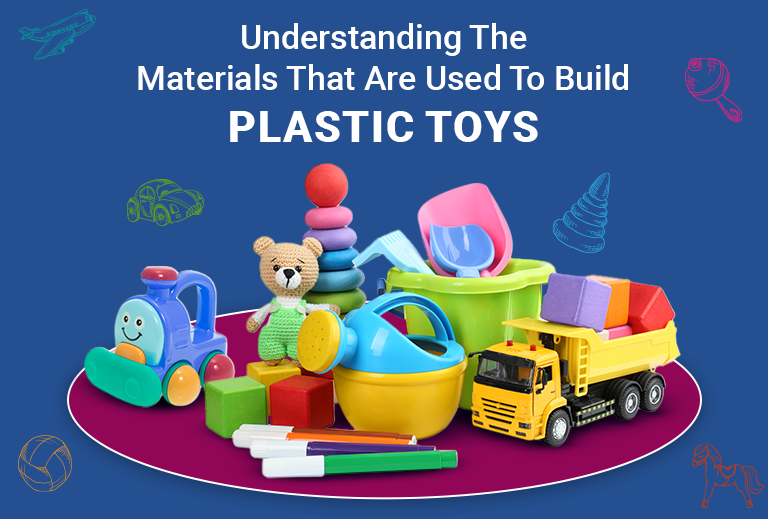Understanding The Materials That Are Used To Build Plastic Toys
The origin of plastic toys can be traced back to the early 20th century. The development and mass production of plastic toys coincided with advancements in plastics manufacturing technology. Bakelite – a thermosetting plastic – was initially used for various industrial and electrical applications in the early 1900s. It was also moulded into toys like chess sets and figurines.
After World War II, there was a surge in plastic toy production as the plastics industry grew. Toys like action figures, dolls, and building blocks made of plastics like polyethylene and polypropylene became more common. In 1958, LEGO, the iconic interlocking plastic building bricks, was introduced by the Danish company of the same name. These toys revolutionized the way children played and built things.
Era of modern-day plastic toys
Over time, there was a growing emphasis on toy safety. Regulations were put in place to ensure that plastic toys were non-toxic and met safety standards. Safe plastic toys that meet safety standards are typically constructed from non-toxic and child-friendly materials. These materials are designed to minimize health risks and ensure the safety of children.
Manufacturers of children’s toys are required to adhere to safety regulations and standards set by organizations like ASTM International and the Consumer Product Safety Commission (CPSC) in the United States.
Common safe plastics used in toy manufacturing include:
- Polyethylene (PE): This plastic is used in a wide range of toys, including outdoor play equipment, water toys, and soft dolls. It’s durable and safe for children.
- Polypropylene (PP): PP is often used for toys like building blocks and board games. It’s known for its durability and safety.
- Polyvinyl Chloride (PVC): PVC is commonly used in bath toys, action figures, and dolls. However, it’s important to note that some PVC toys may contain phthalates, which are considered harmful, so check for phthalate-free PVC toys.
- Acrylonitrile Butadiene Styrene (ABS): ABS is a strong and impact-resistant plastic used in building toys like LEGO blocks. It’s considered safe for children.
- Polyethylene Terephthalate (PET): PET is often used for clear plastic bottles and is considered safe for toy applications like dolls and containers.
- Polyurethane (PU) Foam: PU foam is used in soft, squishy toys, stress balls, and foam puzzles. It’s safe for children due to its soft and cushioning properties.
For a deeper understanding of the plastic toy industry, make sure to not miss attending Plastivision 2023. Taking place from December 7 to 11 at the Bombay Exhibition Centre in Mumbai, this event is set to reveal cutting-edge innovations and advancements in the plastics sector. Moreover, it offers a distinctive networking platform, allowing you to connect with industry leaders and professionals. Save the date and be part of this invaluable event – we eagerly anticipate your presence!
Leave a Reply Cancel reply
Recent Posts
- Understanding The Materials That Are Used To Build Plastic Toys
- All You Need To Know About Food-grade Plastics
- A Glance At The Materials That Boost The Performance Of Plastics
- Understanding The Importance Of Exploring New Business Opportunities In The Plastic Industry
- Understanding The Importance Of Investing in R&D For The Plastic Industry
Categories
- 3D Printing
- AIPMA
- Automation
- Automobile Sector
- Bio Plastics
- Environment
- Innovations In Recycling
- Latest Innovations
- Molds & Dies
- News
- Packaging Industry
- Plastic
- Plastic Application
- Plastic Industry
- Plastic Market
- Plastic Myths
- Plastic News From The World
- Plastic Packaging
- Plastic Products
- Plastic Recycling
- Plastic Solar Cells
- Plastic Toys
- Plastic Waste
- Plastic World
- Plastics
- Plastics And Their Applications
- Plastics In Agriculture
- Plastics In Healthcare
- Plastics In Medical Industry
- Plasticulture
- Processing Machinery
- Recycling Machines
- Robotics
- Uncategorized
- Virtual Reality
Archives
- November 2023 (3)
- October 2023 (2)
- September 2023 (3)
- August 2023 (3)
- July 2023 (3)
- June 2023 (3)
- May 2023 (2)
- April 2023 (2)
- March 2023 (2)
- February 2023 (2)
- January 2023 (2)
- December 2022 (3)
- November 2022 (1)
- October 2022 (1)
- September 2022 (2)
- August 2022 (1)
- July 2022 (3)
- May 2022 (3)
- March 2022 (2)
- February 2022 (1)
- January 2022 (1)
- September 2021 (2)
- August 2021 (3)
- July 2021 (4)
- June 2021 (4)
- May 2021 (3)
- April 2021 (2)
- March 2021 (4)
- November 2019 (8)
- October 2019 (8)
- September 2019 (8)
- August 2019 (8)
- July 2019 (8)
- June 2019 (8)
- May 2019 (8)
- April 2019 (8)
- March 2019 (8)
- February 2019 (11)
- January 2019 (8)
- December 2018 (8)
- November 2018 (12)
- October 2018 (12)

